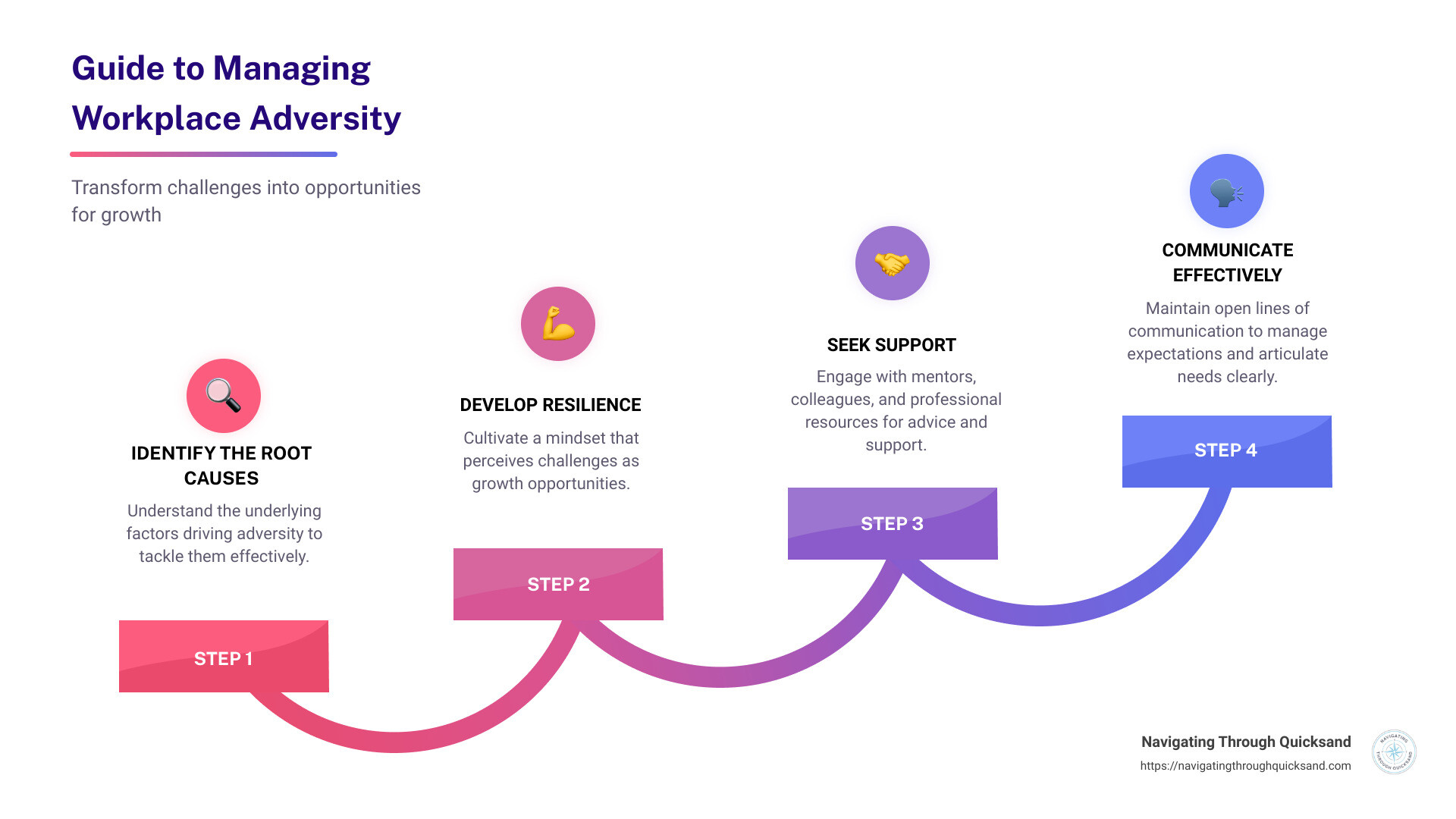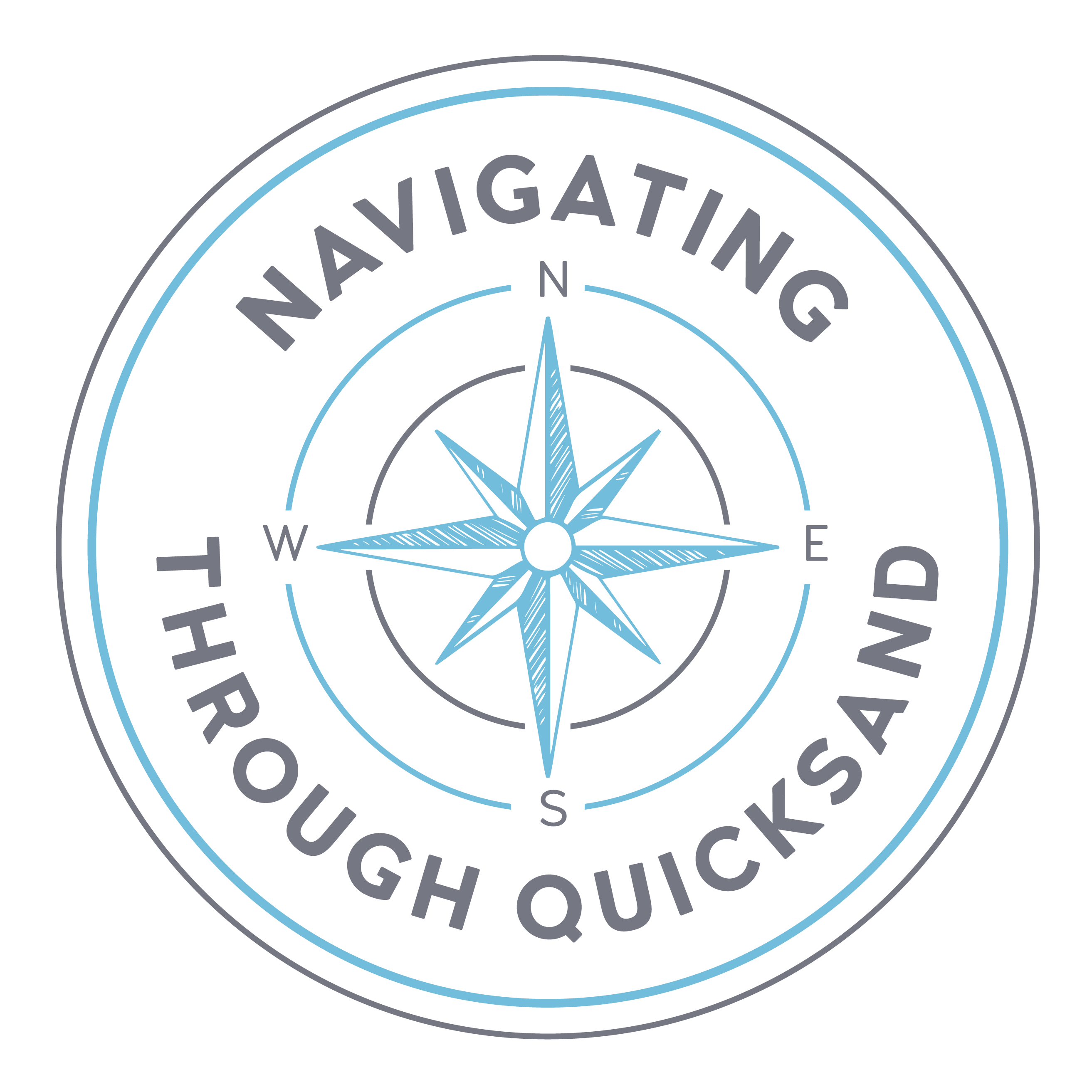Wondering, “What is the best way to manage adversity in the workplace” Navigating through adversity in the business world is more than just a survival tactic; it’s an opportunity to enhance personal and organizational growth. Recognizing the importance of effectively managing workplace challenges is vital for career development and maintaining a healthy work environment. Given that this is a common hurdle for many professionals, understanding foundational strategies prepares you to handle difficulties more adeptly.
Adversity can emerge from various sources—whether interpersonal conflicts, project failures, or external economic pressures—making it essential to have a versatile approach to handle these situations. By outlining simple, practical methods and encouraging a proactive attitude, this guide aims to transform your approach to workplace challenges, leading to more fulfilling and successful professional experiences.
Best Ways to Manage Business Adversity in the Workplace? When you face challenges at work, it’s crucial to adopt a strategic approach conducive to problem-solving and personal growth. Here’s a quick guide:
- Identify the root causes: Understanding what is driving the adversity is the first step.
- Develop resilience: Cultivate a mindset that views challenges as opportunities for growth.
- Invoke positive emotion: Release the emotional grip on problems by thinking of something grateful or a joyful memory, fostering thoughtful solutions.
- Seek support: Engage with mentors, colleagues, and professional resources.
- Communicate effectively: Keep open lines of communication to manage expectations and needs.

Table of Contents
Understanding Adversity in the Workplace
Adversity in the workplace can be tough. It includes any situation where things seem against you—maybe your ideas are ignored, or the workload is overwhelming.
Understanding what this looks like is the first step in managing it effectively. Effective business administration skills are crucial in navigating such challenges, as they equip managers with the ability to quickly recover and respond constructively to adversity, ensuring a strategic plan of action is in place to tackle obstacles within a dynamic business environment.
Definitions
Adversity refers to encounters with difficulties or misfortune. In the workplace, this often manifests as challenges that can disrupt your normal flow of working and cause stress.
Types of Workplace Adversity
Experts like Lisa Rangel have identified several types of adversity you might face at work:
- Financial: Budget cuts or low resources.
- Physical: Overwhelming workloads or long hours.
- Mental and Emotional: Non-supportive colleagues or high-pressure environments.
- Social and Spiritual: Feeling out of place or misaligned with company values.
Understanding these categories helps pinpoint exactly what issue you’re dealing with, making it easier to address.
Examples
- Unrealistic Deadlines: Your boss expects you to complete tasks faster than feasible.
- Lack of Support: Feeling isolated because teammates or managers are not cooperative or dismissive.
- Resource Scarcity: Not having enough tools or information to do your job effectively.
Each of these scenarios represents a form of adversity that can significantly impact your work quality and mental health.
Navigating through these challenges requires awareness and strategies tailored to each type of adversity. By recognizing the specific adversity you’re facing, you can better prepare yourself to tackle it head-on. This understanding is crucial as you move forward to learn more about managing these challenges effectively in subsequent sections of this guide.
What is the Best Way to Manage Adversity in the Workplace?

Managing adversity in the workplace effectively hinges on three critical areas: preparation, support, and mindset. Taking ‘just one step’ at a time is crucial in managing adversity, as it simplifies the approach to solving problems, while aiming to leave a constructive and positive impact on both personal and organizational growth. Each component plays a vital role in building resilience and ensuring you can navigate through challenges with confidence and strategic insight.
Part of building a strong support network involves encouraging employees to address their ‘own issues’ with the backing of their network, fostering a sense of autonomy and resilience.
Building a Support Network
A strong support network is your safety net during turbulent times. Here’s how to build it:
- Colleagues: Foster relationships with coworkers who share similar values and work ethics. They can provide practical advice, emotional support, and a different perspective on the challenges you face.
- Mentors: Seek out mentors within or outside your organization. These are individuals who have navigated similar adversities and can offer guidance, wisdom, and encouragement. For instance, Ashley Gustafson, through her company Navigating Through Quicksand, LLC, emphasizes the importance of mentorship in overcoming workplace challenges.
- Professional Help: Sometimes, professional counselors or coaches can offer tools and strategies beyond the workplace scope that help you manage stress and improve your coping mechanisms.
Developing a Positive Mindset
Your mindset can significantly influence how you perceive and react to adversity. Here’s how to cultivate a positive one:
- Reframing: View challenges as opportunities for growth and learning. This perspective shift can transform your approach and innovation in problem-solving.
- Positivity: Maintain a positive attitude, even in difficult situations. A positive outlook can lead to better health, higher job satisfaction, and greater resilience.
- Growth Mindset: Cultivate a growth mindset by embracing challenges and persisting in the face of setbacks. See every adversity as a chance to develop new skills and improve existing ones.
Preparing for Multiple Outcomes
Being prepared for various outcomes equips you to handle unexpected changes more effectively:
- Planning: Develop clear, actionable plans for different scenarios you might encounter in your role. This helps reduce uncertainty and gives you a clear path to follow during crises.
- Flexibility: Stay flexible in your approach. The ability to adapt to changing circumstances is crucial in managing adversity effectively.
- Scenario Analysis: Regularly engage in scenario analysis to anticipate potential challenges and prepare appropriate responses. This proactive approach not only prepares you for adverse situations but also helps in quick decision-making when they arise.
By integrating these strategies into your daily work life, you can build a robust framework to manage and overcome adversity in the workplace. Each element, from building a supportive network to preparing for various outcomes, plays a crucial role in fostering a resilient and positive work environment. As you move forward, the journey through adversity is not just about surviving but also about thriving and growing both personally and professionally.
Strategies to Overcome Workplace Adversity

Embrace Challenges as Opportunities
One of the most effective strategies to manage adversity in the workplace is to view challenges as opportunities for growth and learning. This approach is rooted in developing a growth mindset, which involves seeing effort as a path to mastery and setbacks as a part of the learning process. By embracing challenges, you can foster innovation and personal development, which not only enhances your skills but also makes you more valuable as an employee.
Tactics to Implement:
- Regularly set personal growth goals related to your work challenges.
- Seek feedback and use it constructively to improve your performance.
- Take on challenging projects to stretch your capabilities.
Maintain Professional Composure
Maintaining composure during difficult times is crucial. This involves managing your emotions and reactions, which is where emotional intelligence comes into play. Being able to stay calm and composed helps in making rational decisions and communicates confidence and reliability to your colleagues and superiors.
Stress management techniques such as deep breathing exercises, regular physical activity, and mindfulness meditation can help you maintain your composure. Additionally, always remember to reflect on the situation rather than reacting impulsively.
Tactics to Implement:
- Practice mindfulness to enhance your awareness and control over your reactions.
- Develop a routine that includes activities to reduce stress.
- Keep communication open and professional, regardless of the situation.
Activate Social Support
Building and activating a network of support within your workplace is essential. This network can include colleagues, mentors, and even professional help if necessary. Networking and fostering a sense of community in the workplace can provide you with the resources and support needed to navigate through tough times.
Teamwork should not be underestimated. Collaborating with others can help in sharing the load during challenging periods, and also provides different perspectives that might help in solving problems more efficiently.
Tactics to Implement:
- Participate in team-building activities to strengthen bonds with colleagues.
- Establish regular check-ins with mentors or a professional coach.
- Offer help to colleagues when they face challenges, fostering a supportive work environment.
By integrating these strategies into your daily work life, you can build a robust framework to manage and overcome adversity in the workplace. Each element, from embracing challenges as opportunities to activating social support, plays a crucial role in fostering a resilient and positive work environment. As you move forward, the journey through adversity is not just about surviving but also about thriving and growing both personally and professionally.
Practical Tips for Everyday Adversity

Use Humor and Faith
In the face of workplace adversity, maintaining a light-hearted approach and a strong belief system can be transformative. Here’s how you can integrate these elements into your daily routine:
- Laughter: It’s often said that laughter is the best medicine. In the workplace, humor can defuse tension and foster camaraderie among colleagues. Try sharing a funny story during breaks or sending a humorous, work-appropriate meme to your team chat. It can lighten the mood and make challenges seem more manageable.
- Belief: Holding onto personal beliefs or a broader perspective can provide comfort and guidance during tough times. Whether it’s a spiritual faith or a deeply held value, let this belief be your anchor. Reflect on how your work aligns with these values, reinforcing why you persevere.
- Perspective: Keep challenges in perspective by reminding yourself that adversity is often temporary. Consider past obstacles you’ve overcome and recognize your growth from those experiences. This can boost your morale and encourage a resilient mindset.
Stay Disciplined and Focused
Discipline and focus are your allies in navigating workplace adversity. Here’s how to cultivate these traits:
- Routine: Establish a daily routine that includes time for both work and relaxation. This structure can provide a sense of control amidst chaos. Start your day with a planning session, outlining your key tasks and goals, which can help in prioritizing effectively.
- Habits: Develop positive work habits that promote efficiency. This could be as simple as organizing your workspace at the end of each day or setting specific times to check emails. These habits reduce stress and free up mental space for tackling bigger challenges.
- Goals: Set clear, achievable goals. Break larger objectives into smaller, manageable tasks with deadlines. This helps maintain focus and provides a roadmap to success, keeping you motivated even when the going gets tough.
- Prioritization: Learn to prioritize tasks based on urgency and importance. Use tools like the Eisenhower Box to distinguish between tasks that require immediate attention and those that can wait. This helps in managing workload and reducing burnout.
- Consistency: Be consistent in your efforts. Regularity in your work ethic, no matter how small the task, builds resilience and capability to handle adversity. Consistency also sets a positive example for others in your team, fostering a resilient group dynamic.
By incorporating humor and faith, and staying disciplined and focused, you can effectively manage everyday adversity in the workplace. These practical tips not only help in overcoming immediate challenges but also contribute to long-term personal and professional growth. As you implement these strategies, each step forward, no matter how small, is progress in building a resilient and fulfilling career.
Conclusion
As we wrap up our discussion on managing adversity in the workplace, it’s clear that this challenge, though daunting, can be a powerful catalyst for personal and professional growth. By understanding the nature of adversity, building strong support networks, maintaining a positive mindset, and preparing for various outcomes, individuals and teams can transform challenges into stepping stones towards success.
At Navigating Through Quicksand, LLC, we are committed to empowering you to turn the quicksand of life’s challenges into a firm foundation upon which you can build success. Whether through our workshops, coaching sessions, or motivational speaking, we aim to ignite a passion for navigating through and rising above adversity.
Contact us today and let us help you and your organization not just to manage adversity but to thrive in the face of it. Together, we can make each challenge a story of triumph and each struggle a lesson in resilience. Thank you for joining us on this journey, we are here to support you every step of the way. Let’s turn your adversities into assets!
Our Content
Our content is carefully created and edited by Ashley Gustafson to ensure that the content is accurate, reliable, and up-to-date. Navigating Through Quicksand, LLC is a trusted inspirational woman, inspirational speaker, and personal development coach in Massachusetts for confidence coaching programs for women such as leadership workshops, communication workshops, low self-confidence programs, and more. Navigating Through Quicksand, LLC has empowered individuals with over 15 years of experience working with students and athletic teams from local communities.



